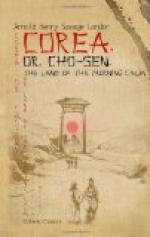It is generally the sons of the nobles and the upper classes all over the kingdom who are put up for these examinations; those of the lower spheres are content with a smattering of arithmetic and a general knowledge of the alphabet, and of the proper method of holding the writing brush, sometimes adding to these accomplishments an acquaintance with the more useful of the Chinese characters.
The Corean alphabet is remarkable for the way in which it represents the various sounds. That this is the case, the reader will be able to judge by the table given opposite. The aim of the inventors, in only using straight lines and circles, has evidently been to simplify the writing of the characters to the highest possible degree.
[Illustration: THE COREAN ALPHABET]
It will be at once noticed that an extra dot is used only in the case of the vowel e and the diphthong oue; nothing but straight lines and circles being employed in the other cases. The pronunciation of the consonants is dental in l, r, t, and n; guttural in k and k (aspirated); palatal in ch, ch (aspirated) and s; and from the larynx in h and ng when at the end of a word.
The State documents and all the official correspondence are written in Chinese characters, and hardly at all in the native alphabet, an exception being occasionally admitted in the case of a difficult character, when the meaning is written with the Corean letters, side by side with the Chinese form. The Corean alphabet is rather despised by the male “blue stockings” of Cho-sen, and is considered as fit only for poor people, children and women; in short, those whose brains are unable to undergo the strain of mastering and, what is more, of remembering, the meaning of the many thousands of Chinese characters. Not only that, but the spoken language itself is considered inadequate to express in poetic and graceful style the deep thoughts which may pass through the Corean brains; and, certainly, if these thoughts have to be put down on paper this is never done in the native characters. The result is, naturally, that there is hardly any literature in the language of Cho-sen. Even the historical records of the land of the Morning Calm are written in Chinese.
The great influence of the Chinese over the Corean literary mind is also shown in the fact that most of the principles and proverbs of Cho-sen have been borrowed from their pig-tailed friends across the Yalu River. The same may be said of numberless words in the Corean language which are merely corruptions or mispronounced Chinese words. The study of Chinese involves a great deal of labour and patience on the part of the Corean students, and from a very tender age they are made to work hard at learning the characters by heart, singing them out in chorus, in a monotonous tone, one after the other for hours at a time.




